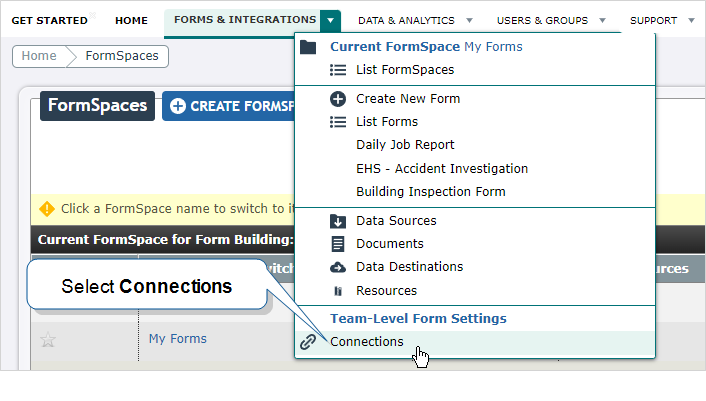Connections Overview
Data Sources![]() Data sources, also known as "Lookups", are external sources of data that you upload or connect to TrueContext. You can reference this data in a form to populate answers or answer options. Data sources save typing, reduce errors, and make it easy to provide mobile users with only the relevant, most current data. and Data Destinations
Data sources, also known as "Lookups", are external sources of data that you upload or connect to TrueContext. You can reference this data in a form to populate answers or answer options. Data sources save typing, reduce errors, and make it easy to provide mobile users with only the relevant, most current data. and Data Destinations![]() A Data Destination specifies where to send data from a submitted form. You can use Data Destinations to automate data sharing and storage, routing data to a specific service (such as email or cloud storage) in several different formats. use Connections
A Data Destination specifies where to send data from a submitted form. You can use Data Destinations to automate data sharing and storage, routing data to a specific service (such as email or cloud storage) in several different formats. use Connections![]() A Connection is an integration point that's used to link a TrueContext Data Source or Data Destination to an external service to import or export data. Data Destinations and Data Sources that share the same external service can also share the same Connection. to exchange data with external services. Data Sources import data from these external services, and Data Destinations route data to them. Only Team Admins (Admin users) can set up Connections, but they’re available to all Data Destinations and Data Sources within team FormSpaces. This topic describes how Connections work and how to set them up.
A Connection is an integration point that's used to link a TrueContext Data Source or Data Destination to an external service to import or export data. Data Destinations and Data Sources that share the same external service can also share the same Connection. to exchange data with external services. Data Sources import data from these external services, and Data Destinations route data to them. Only Team Admins (Admin users) can set up Connections, but they’re available to all Data Destinations and Data Sources within team FormSpaces. This topic describes how Connections work and how to set them up.
Available on all tiers, with more options on the Advanced and Enterprise tiers:
Contents
How Connections work
Connection reuse
Connections streamline the process of creating new Data Sources and Destinations. Each Data Source![]() Data sources, also known as "Lookups", are external sources of data that you upload or connect to TrueContext. You can reference this data in a form to populate answers or answer options. Data sources save typing, reduce errors, and make it easy to provide mobile users with only the relevant, most current data. and Destination can simply use an existing Connection without the need to re-enter credentials. This is especially useful for organizations that have multiple Data Sources and Destinations connected to the same service.
Data sources, also known as "Lookups", are external sources of data that you upload or connect to TrueContext. You can reference this data in a form to populate answers or answer options. Data sources save typing, reduce errors, and make it easy to provide mobile users with only the relevant, most current data. and Destination can simply use an existing Connection without the need to re-enter credentials. This is especially useful for organizations that have multiple Data Sources and Destinations connected to the same service.
For example, the Amazon Web Services Connection can be used by the Amazon S3 Data Source and the Amazon S3 Data Destination![]() A Data Destination specifies where to send data from a submitted form. You can use Data Destinations to automate data sharing and storage, routing data to a specific service (such as email or cloud storage) in several different formats..
A Data Destination specifies where to send data from a submitted form. You can use Data Destinations to automate data sharing and storage, routing data to a specific service (such as email or cloud storage) in several different formats..
Credentials and data access
In TrueContext, when a Team Admin sets up a Connection, they enter the account credentials for the third-party system. Once they save the Connection, it becomes available to TrueContext and other users for Data Source and Data Destination setup. This means that other TrueContext users on the team can fetch and access data available to the third-party user account.
Note:We recommend that you create a dedicated Integration User account for your third-party system and use that account to set up TrueContext Connections. Set up the Integration User with specific permissions and limited access to the third-party system data. This ensures that TrueContext Admin users and users with “Can Create” permissions can only access the data that they need.
Create a Connection
Connections can be created from the Connections page or directly from the configuration options for any Data Source or Destination.
Connections page
-
From the main menu, hover over Forms & Integrations.
-
Select Connections.
-
On the following page, select Create Connection.
-
Follow the configuration instructions for the selected connection type.
Data Source or Destination Connection tab
-
When creating or editing a Data Source or Destination, go to the Connection tab.
-
Select Create a New Connection.
-
Follow the configuration instructions for the selected connection type.
Connection Types
Generic Backend Integration
Available on all tiers:
Available on the Advanced and Enterprise tiers:
Business Software Integration
Available on the Advanced and Enterprise tiers:
Cloud Service Integration
Available on all tiers:
- Dropbox Connection
- Google Connection
- Microsoft OneDrive Connection
- Microsoft 365 Connection
- Box Connection
Available on the Advanced and Enterprise tiers:
Available on the Enterprise tier only:


